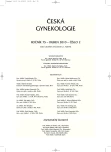Peripartum hysterectomy – an audit in Slovakia in 2007
Authors:
M. Mlynček 1,2; M. Kellner 1; P. Uharček 1,2; M. Matejka 1; E. Lajtman 1; M. Boledovičová 2
Authors‘ workplace:
Gynekologicko-pôrodnícka klinika Fakultnej nemocnice, Nitra
1; Univerzita Konštantína Filozofa v Nitre, vedúci prof. MUDr. M. Mlynček, CSc.
2
Published in:
Ceska Gynekol 2010; 75(2): 88-92
Overview
Objective:
An audit was performed to assess the number, indications and complications of peripartum hysterectomy at the departments of obstetrics/gynecology in Slovakia in 2007.
Design:
Observational descriptive study.
Setting:
Department of Obstetrics and Gynecology, Faculty Hospital Nitra and Constantine the Philosopher University Nitra.
Method:
An official questionnaire of Slovak Society of Obstetrics and Gynecology was sent to all 63 departments of obstetrics/gynecology to find the number of peripartum hysterectomy performed in the year 2007. Differences between intrapartum and postpartum cases were compared.
Results:
44 from 63 institutions responded to the survey (response rate 69.8%). There were 38,485 deliveries and 24 cases of peripartum hysterectomies.
The incidence of peripartum hysterectomy was 0.62/1000 deliveries, 1 case occurred in 1,604 deliveries. 16 (66.7%) patients had a total abdominal hysterectomy with the remaining 8 (33.3%) having a sub-total hysterectomy. All operations were emergent. 18 procedures were performed during delivery and 6 in the postpartum period. Hypogastric artery ligation before hysterectomy were performed on 2 patients in the postpartum group. 20 of 24 (83.3%) patients delivered by cesarean section, three (12.5%) by spontaneous vaginal delivery and one (4.2%) with vaccumextraction. The indications for emergency peripartum hysterectomy were: placenta praevia 6 cases (25%), placental abruption with disseminated intravascular coagulation 6 (25%), placenta accreta 3 (12.5%), uterine atony 3 (12.5%), uterine rupture 3 (12.5%) and retroperitoneal haematoma 3 (12.5%). The youngest patient was 15 year-old, the oldest one was 39. After hysterectomy 10 (41.7%) women were admitted to the intensive care unit. There was no maternal mortality, but five newborns died due to perinatal asphyxia. There were more blood transfusions in the group of postpartum hysterectomies in comparison with intrapartum cases (4.0±1.3 transfusion units vs 9.1±3.5, p< 0.05), as well as the longer hospital stay (10.3±s4.2 days vs 19.1±5.3, p< 0.05).
Conclusions:
Peripartal hysterectomy is a dramatic but a life saving procedure. It is usually associated with significant maternal and fetal morbidity and mortality.
Every obstetric service should have access to a surgical team capable of performing emergency peripartal hysterectomy.
Key words:
cesarean section, haemorrhage, peripartum hysterectomy, risk factors.
Sources
1. Bakshi, S., Meyer, BA. Indications for and outcomes of emergency peripartum hysterectomy. A five-year review. J Reprod Med 2000, 45, p. 733-737.
2. Bodelon, C., Bernabe-Ortiz, A., Schiff, MA., Reed, SD. Factors associated with peripartum hysterectomy. Obstet Gynecol 2009, 114, p. 115-123.
3. Castaneda, S., Karrison, T., Cibils, LA. Peripartum hysterectomy. J Perinat Med 2000, 28, p. 472-481.
4. Daskalakis, G., Anastasakis, E., Papantoniou, N., et al. Emergency obstetric hysterectomy. Acta Obstet Gynecol Scand 2007, 86, p. 223-227.
5. Dindelli, M., Ferrari, S., Potenza, MT., et al. Ablative Cesarean section and post-partum hysterectomy: review of 11 years of obstetric practice. Ann Obstet Ginecol Med Perinat 1991, 112, p. 179-187.
6. Engelsen, IB., Albrechtsen, S., Iversen, OE. Peripartum hysterectomy - incidence and maternal morbidity. Acta Obstet Gynecol Scand 2001, 80, p. 409-412.
7. Feyereisl, J. Závažné postpartální hemoragie a doporučený postup k léčbě. Čes Gynek 2008, 73, s. 375-379.
8. Flood, KM., Said, S., Geary, M., et al. Changing trends in peripartum hysterectomy over the last 4 decades. Am J Obstet Gynecol 2009, 200, 632, e1-6.
9. Glaze, S., Ekwalanga, P., Roberts, G., et al. Peripartum hysterectomy: 1999 to 2006. Obstet Gynecol 2008, 111, p. 732‑738.
10. Korbeľ, M., Borovský, M., Danko, J., et al. Regionálna analýza perinatálnych výsledkov v SR za rok 2007. Gynek Prax 2009, 7, s. 9-14.
11. Langdana, F., Geary, M., Haw, W., Keane, D. Peripartum hysterectomy in the 1990s: any new lessons? J Obstet Gynaecol 2001, 21, p. 121-123.
12. Lind, T., Wegnelius, G., Grunewald, C. More and more Cesarean sections resulted in more and more postpartum hysterectomies. New care program turned the trend according to a retrospective study. Lakartidningen 2009, 106, p. 1005-1007.
13. Plauché, WC. Caesarean hysterectomy: indications, technique, and complications. Clin Obstet Gynecol 1986, 29, p. 318-324.
14. Plauché, WC. Peripartal hysterectomy. Obstet Gynecol Clin North Am 1988, 15, p. 783-795.
15. Remy, N., Jaluvka, V., Weitzel, HK. Peripartal hysterectomy—definition, follow-up and risk. Geburtshilfe Frauenheilkd 1994, 54, p. 593-597.
16. Roopnarinesingh, R., Fay, L., McKenna, P. A 27-year review of obstetric hysterectomy. J Obstet Gynaecol 2003, 23, p. 252-254.
17. Schrimmer, DB., Paul, RH., Mishell, DR. Jr. Emergency peripartum hysterectomy and associated risk factors. Am J Obstet Gynecol 1993, 168, p. 879-883.
18. Sheiner, E., Levy, A., Katz, M., Mazor, M. Identifying risk factors for peripartum Cesarean hysterectomy. A population-based study. J Reprod Med, 2003, 48, p. 622-626.
19. Todman, A. A history of Cesarean section: from ancient world to the modern era. Aust N Z J Obstet Gynaecol 2007, 47, p. 357-361.
20. Umezurike, CC., Feyi-Waboso, PA., Adisa, CA. Peripartum hysterectomy in Aba southeastern Nigeria. Aust N Z J Obstet Gynaecol 2008, 48, p. 580-582.
21. Wicherek, L., Galazka, K. The possible correlation between the patient’s immune tolerance level during Cesarean section and the incidence of subsequent emergency peripartum hysterectomy. Clin Dev Immunol 2007, 63596. doi: 10.1155/2007/63596.
22. Yucel, O., Ozdemir, I., Yucel, N., Somunkiran, A. Emergency peripartum hysterectomy: a 9-year review. Arch Gynecol Obstet 2006, 274, p. 84-87.
Labels
Paediatric gynaecology Gynaecology and obstetrics Reproduction medicineArticle was published in
Czech Gynaecology

2010 Issue 2
Most read in this issue
- Current possibilities for diagnosis of vulvovaginal infection
- Significance of hysteroscopic resection in diagnostics of endometrial cancer
- Recommendation for hormone replacement therapy in postmenopause
- New Single-Incision Sling System MiniArc in treatment of the female stress urinary incontinence
